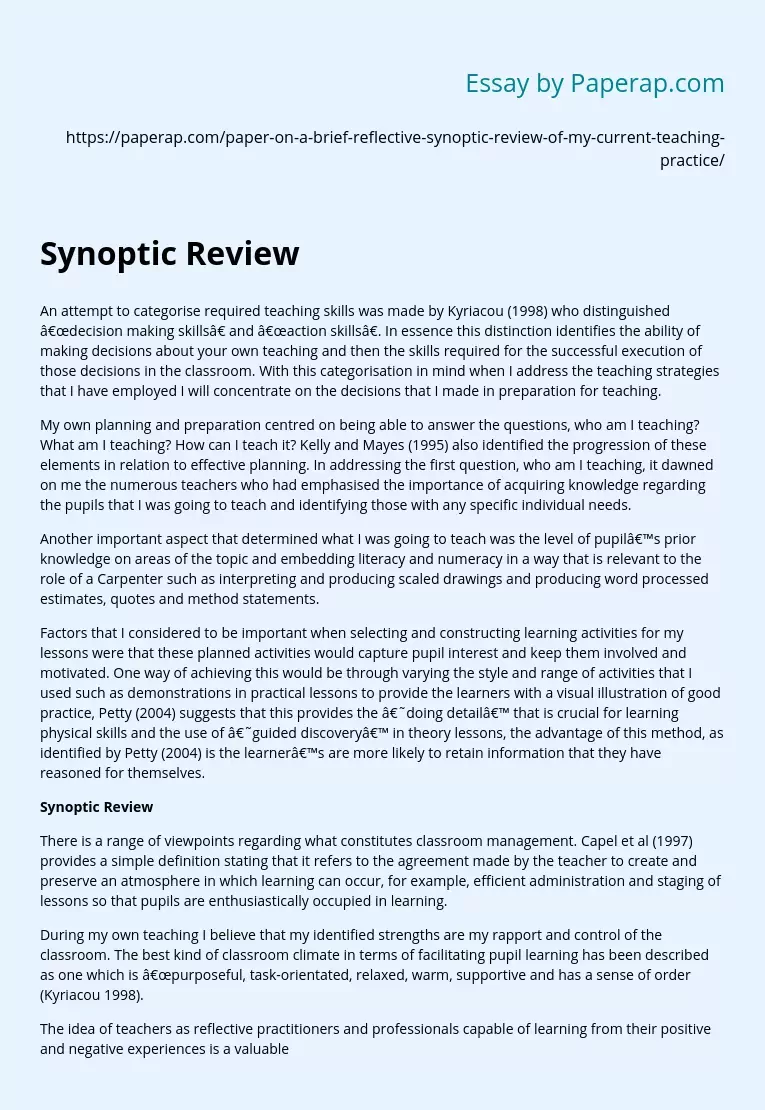Synoptic Review
An attempt to categorise required teaching skills was made by Kyriacou (1998) who distinguished “decision making skills” and “action skills”. In essence this distinction identifies the ability of making decisions about your own teaching and then the skills required for the successful execution of those decisions in the classroom. With this categorisation in mind when I address the teaching strategies that I have employed I will concentrate on the decisions that I made in preparation for teaching.
My own planning and preparation centred on being able to answer the questions, who am I teaching? What am I teaching? How can I teach it? Kelly and Mayes (1995) also identified the progression of these elements in relation to effective planning.
In addressing the first question, who am I teaching, it dawned on me the numerous teachers who had emphasised the importance of acquiring knowledge regarding the pupils that I was going to teach and identifying those with any specific individual needs.
Another important aspect that determined what I was going to teach was the level of pupil’s prior knowledge on areas of the topic and embedding literacy and numeracy in a way that is relevant to the role of a Carpenter such as interpreting and producing scaled drawings and producing word processed estimates, quotes and method statements.
Factors that I considered to be important when selecting and constructing learning activities for my lessons were that these planned activities would capture pupil interest and keep them involved and motivated. One way of achieving this would be through varying the style and range of activities that I used such as demonstrations in practical lessons to provide the learners with a visual illustration of good practice, Petty (2004) suggests that this provides the ‘doing detail’ that is crucial for learning physical skills and the use of ‘guided discovery’ in theory lessons, the advantage of this method, as identified by Petty (2004) is the learner’s are more likely to retain information that they have reasoned for themselves.
Synoptic Review
There is a range of viewpoints regarding what constitutes classroom management. Capel et al (1997) provides a simple definition stating that it refers to the agreement made by the teacher to create and preserve an atmosphere in which learning can occur, for example, efficient administration and staging of lessons so that pupils are enthusiastically occupied in learning.
During my own teaching I believe that my identified strengths are my rapport and control of the classroom. The best kind of classroom climate in terms of facilitating pupil learning has been described as one which is “purposeful, task-orientated, relaxed, warm, supportive and has a sense of order (Kyriacou 1998).
The idea of teachers as reflective practitioners and professionals capable of learning from their positive and negative experiences is a valuable asset that can serve to aid professional growth and progress. These questions should then be continuously asked, have I been an effective teacher? Have I used the most appropriate teaching and learning strategies? Kyriacou (1998) defines effective teaching as “that which successfully achieves the learning by pupils intended by the teacher”. In relation to this definition the answer that is closest to the reality of my initial experience is that there were both lessons that illustrated effective teaching and ones which did not. Those instances that were successful were characterised by appropriate use of a range of varied teaching and learning strategies. Those lessons, which were not so effective, were characterised by ill appropriate use or even lack of clear strategies.
In terms of teaching strategies effective lessons were based upon careful consideration of what were to be learning outcomes and ensuring that the selection of activities would facilitate these outcomes.
In terms of learning strategies, when I had consistently applied rules and expectations, and used an array of monitoring techniques within the classroom I was able to create and maintain an environment that promoted learning. The greater the amount of time and thought that went into promoting different styles of learning in the classroom coupled with regular and positive forms of feedback and assessment all combined to result in a productive and fulfilling learning experience for both myself and my pupils.
Synoptic Review. (2019, Dec 05). Retrieved from https://paperap.com/paper-on-a-brief-reflective-synoptic-review-of-my-current-teaching-practice/

